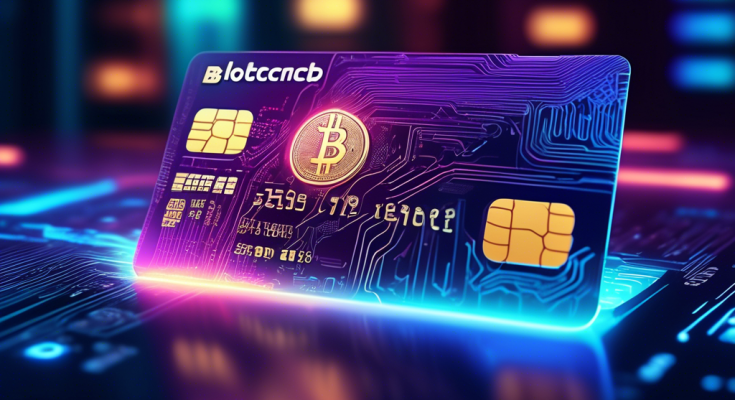Introduction
In an era where digital currency is increasingly becoming mainstream, the advent of the crypto card is poised to change how we spend and manage our finances. Unlike traditional bank cards, crypto cards offer a seamless and efficient way to use cryptocurrencies for everyday purchases, providing a bridge between the conventional financial system and the burgeoning world of digital assets. As more people seek innovative solutions to optimize their financial transactions, understanding the potential and functionality of crypto cards becomes essential.
This article delves into the fundamentals of crypto cards, explores their benefits in daily transactions, and looks ahead to future trends and innovations that could further revolutionize our financial landscape. Whether you are a seasoned crypto enthusiast or new to digital currencies, gaining insights into how crypto cards operate and their myriad advantages can pave the way for more informed financial decisions.
What is a Crypto Card? Understanding the Basics
Definition and Purpose of a Crypto Card
A crypto card is a financial tool designed to bridge the gap between the digital currency ecosystem and the conventional financial system. Essentially, it allows holders to spend various types of cryptocurrencies in much the same way as they would use traditional bank cards like debit or credit cards. The primary purpose of a crypto card is to enhance the usability of digital currencies, making it seamless and convenient for users to engage in everyday transactions without needing to convert their assets to fiat currencies first.
How Crypto Cards Function in Comparison to Traditional Bank Cards
Crypto cards function similarly to traditional bank cards but have some significant distinctions. When a user makes a purchase with a crypto card, the value of the transaction is deducted from their cryptocurrency balance rather than a bank account. Depending on the service provider, the cryptocurrency may be instantly converted to the local fiat currency at the point of sale, allowing for immediate interactions within traditional financial frameworks.
For example, if you hold Bitcoin in your crypto card account and you make a purchase in dollars, the corresponding amount of Bitcoin is sold, converting it to dollars, which are then used to complete the transaction. This automatic conversion allows users to spend their digital assets without needing to manually exchange them first. Unlike traditional cards, which are intrinsically linked to a specific currency and bank account, crypto cards offer unparalleled flexibility and are inherently tied to the dynamic and decentralized nature of the cryptocurrency world.
Key Features and Benefits of Using a Crypto Card
The most striking feature of a crypto card is its ability to utilize multiple cryptocurrencies for everyday expenses. This flexibility makes it highly versatile and user-friendly. Here are some core features and benefits:
1. Multi-Currency Support
Crypto cards often support a wide variety of cryptocurrencies, including Bitcoin, Ethereum, Litecoin, and many more. This capacity not only provides a broader scope for spending across different cryptocurrencies but also enables users to capitalize on their diverse digital assets.
2. Seamless Conversion
As mentioned earlier, crypto cards facilitate instant conversion of cryptocurrencies to fiat currencies at the point of sale. This eliminates the need for manual exchanges and helps users avert potential delays and additional fees associated with traditional conversion methods.
3. Global Usability
Crypto cards can typically be used anywhere traditional bank cards are accepted, offering global reach. This is particularly advantageous for frequent travelers or expatriates who can transact in different countries without incurring significant foreign exchange fees.
4. Lower Transaction Fees
Many crypto card providers offer lower transaction fees compared to conventional banks or foreign exchange services. In some cases, they waive fees altogether for certain types of transactions, which can significantly reduce the cost burden for consumers.
5. Enhanced Security
Crypto cards often come with built-in security features, such as two-factor authentication, biometric verification, and advanced encryption techniques. These measures ensure that users’ digital assets are protected against fraud and unauthorized access.
6. Rewards and Cashback Programs
Just like traditional credit cards, many crypto cards offer rewards and cashback on purchases. These incentives can be highly attractive to users, providing additional value for their spending. Rewards can be in the form of cryptocurrency, which can appreciate in value over time, adding a layer of potential investment return.
In summary, a crypto card represents a groundbreaking development in the financial world, simplifying the process of spending digital currencies and integrating them into the global economy. With its user-centric features, it stands as a testament to the evolving landscape of digital finance, merging the worlds of cryptocurrency and traditional banking in innovative ways.
The Benefits of Using a Crypto Card for Everyday Transactions
Enhanced Security Measures in Crypto Card Transactions
One of the standout advantages of using a crypto card for everyday transactions is its enhanced security features. Unlike traditional bank cards, which can be prone to fraud and identity theft, crypto cards offer a higher level of security thanks to blockchain technology. Blockchain’s decentralized nature makes it exceedingly difficult for hackers to alter or manipulate transaction data, providing an extra layer of protection for users.
Moreover, many crypto cards come with additional security protocols such as two-factor authentication (2FA), biometric verification, and real-time transaction alerts. These measures ensure that only the cardholder can authorize transactions, reducing the risk of unauthorized use.
Another compelling security feature is the encryption of transaction data. Transactions conducted with a crypto card are encrypted, ensuring that sensitive information like card details and personal identification numbers (PINs) remain confidential. This encryption mitigates the risk of data breaches and unauthorized access, which can be a significant concern with traditional financial systems.
Financial Flexibility and Global Usability
Crypto cards offer unparalleled financial flexibility and global usability, making them an excellent choice for frequent travelers and international shoppers. Unlike traditional bank cards that might impose restrictions and exorbitant fees on international transactions, crypto cards allow users to spend their digital currency seamlessly across borders.
One key benefit is the immediate conversion of cryptocurrency to local currency at the point of sale. This feature eliminates the need to exchange currency beforehand or deal with fluctuating exchange rates. Users can make purchases in any country without having to worry about local currency availability or exchange rate losses.
Furthermore, the financial flexibility of crypto cards extends to their versatile funding options. Users can link multiple types of cryptocurrencies to a single card, providing them with the freedom to choose which digital asset to use for each transaction. This capability is particularly advantageous in times of market volatility, allowing cardholders to optimize their spending based on real-time cryptocurrency values.
Another aspect of global usability is the broad acceptance of crypto cards by merchants worldwide. Major credit card networks like Visa and Mastercard have partnered with crypto card providers, enabling these cards to be used at millions of locations globally. This extensive acceptance ensures that users can rely on their crypto card for all types of transactions, from everyday purchases to high-value expenses.
Potential for Lower Fees and Rewards Programs
One of the most appealing benefits of using a crypto card is the potential for lower fees and lucrative rewards programs. Traditional bank cards often come with a slew of fees, including annual fees, foreign transaction fees, and cash advance fees. In contrast, many crypto card providers offer fee structures that are more transparent and cost-effective.
For example, some crypto cards do not charge any foreign transaction fees, making them ideal for international use. Additionally, withdrawal fees for accessing cash through ATMs can be significantly lower with a crypto card compared to traditional banking options. This reduction in fees can lead to substantial savings over time, particularly for individuals who travel frequently or conduct numerous international transactions.
Beyond lower fees, many crypto cards offer attractive rewards programs that can provide additional value to cardholders. These rewards can come in various forms, such as cashback, cryptocurrency rewards, or discounts on purchases. Some crypto cards even allow users to earn rewards in the form of popular cryptocurrencies like Bitcoin or Ethereum, offering the potential for these rewards to appreciate in value over time.
Moreover, the flexibility in redeeming rewards is often superior with crypto cards. Cardholders can typically choose how they want to use their earned rewards, whether by converting them into various cryptocurrencies, using them for future purchases, or even staking them for potential yields. This versatility ensures that users can maximize the benefits based on their financial goals and market conditions.
In summary, the enhanced security measures, financial flexibility, global usability, and potential for lower fees and rewards programs make crypto cards an attractive option for everyday transactions. By leveraging these advantages, users can enjoy a more secure, cost-effective, and rewarding experience when spending their digital currency.
The Future of Crypto Cards: Trends and Innovations
Emerging Technologies and Improvements in Crypto Card Functionality
The landscape of digital currency is constantly evolving, and crypto cards are no exception. As more individuals and businesses begin to embrace cryptocurrencies, several technological advancements are set to enhance the functionality of crypto cards significantly. One major area of innovation is the integration of blockchain technology to improve the security and transparency of transactions.
Next-generation crypto cards are expected to feature enhanced blockchain protocols that ensure faster transaction speeds and reduced processing time. This will make it possible for users to complete purchases almost instantaneously, rivaling even the fastest traditional payment methods available today. Furthermore, the implementation of smart contracts could automate various aspects of the transaction process, reducing the chances of human error and fraud.
Another emerging trend is the adoption of multi-currency digital wallets within crypto cards. Such wallets would allow users to hold and spend multiple types of cryptocurrency and even fiat currency without needing multiple cards. The ability to seamlessly switch between different forms of currency will not only provide greater convenience but also open up a new realm of financial flexibility.
Predictions for Market Adoption and Industry Integration
Market analysts predict substantial growth in the adoption of crypto cards, driven by a combination of increasing cryptocurrency acceptance and technological advancements. Financial institutions and fintech companies are investing heavily in developing crypto card solutions tailored to a wide range of user needs. This investment is expected to foster greater integration between conventional financial systems and emerging digital currencies.
One notable prediction is the rise of hybrid cards, which combine features of traditional credit and debit cards with the unique attributes of crypto cards. These hybrid cards will likely offer users the option to choose between spending traditional currency or cryptocurrency at the point of sale. Such a development will make crypto cards more versatile and practical for everyday use, propelling market adoption even further.
Moreover, strategic partnerships between crypto card providers and mainstream retail and service providers are anticipated to proliferate. These partnerships will enable smoother transactions across a variety of platforms, making it easier for users to spend their digital currencies. For example, popular e-commerce websites and physical retailers may start accepting payments directly through crypto cards, thus narrowing the gap between digital currencies and day-to-day financial activities.
Potential Challenges and Opportunities for Crypto Card Users
While the future of crypto cards looks promising, several challenges must be addressed to ensure widespread adoption. One major concern is regulatory compliance. As governments worldwide tighten regulations around cryptocurrencies, crypto card providers must navigate a complex web of legal requirements. Ensuring compliance while offering a seamless user experience will be a critical challenge moving forward.
Another potential obstacle is the volatility of cryptocurrency values. Since cryptocurrencies are known for abrupt price fluctuations, maintaining a stable value in terms of everyday purchasing power can be difficult. To mitigate this, some crypto card providers are exploring the use of stablecoins, which are pegged to a stable asset like the US dollar. Integrating stablecoins could provide a more predictable spending experience for users.
Despite these challenges, the opportunities for crypto card users are vast. For instance, crypto cards can offer unparalleled financial inclusion, especially for those in regions with limited access to banking infrastructure. With merely an internet connection, individuals can participate in the global economy, making payments and receiving funds with ease.
Additionally, comprehensive rewards programs tailored to crypto card users have the potential to attract a broad user base. By offering incentives such as cashback in cryptocurrency or discounts for using specific blockchain services, providers can create a more engaged and loyal user community.
In conclusion, the future of crypto cards is bright, marked by significant technological advancements, greater market adoption, and a wealth of opportunities for both users and providers. As the digital currency ecosystem continues to mature, crypto cards will likely become an integral part of everyday financial activities, revolutionizing the way we spend digital currency.
Conclusion: Embracing the Future with Crypto Cards
As our financial systems continue to evolve in the digital age, the advent of the crypto card stands out as a transformative development. By seamlessly merging the advanced benefits of digital currencies with the familiarity and convenience of traditional bank cards, crypto cards have the potential to revolutionize the way we handle day-to-day transactions.
The enhanced security measures, financial flexibility, and potential for low fees and rewards programs make crypto cards a compelling choice for both seasoned digital currency enthusiasts and newcomers alike. With ongoing innovations and emerging technologies set to further improve their functionality, the future of crypto cards appears incredibly promising.
Although challenges in market adoption and industry integration remain, the opportunities for users to benefit from a streamlined, globally usable financial tool are vast. By embracing crypto cards, individuals can be at the forefront of a financial revolution, enjoying a versatile and secure way to spend digital currencies.
Ultimately, the widespread adoption of crypto cards could signify a major shift towards a more decentralized and efficient financial future, shaping the way we think about and use money in our everyday lives.





